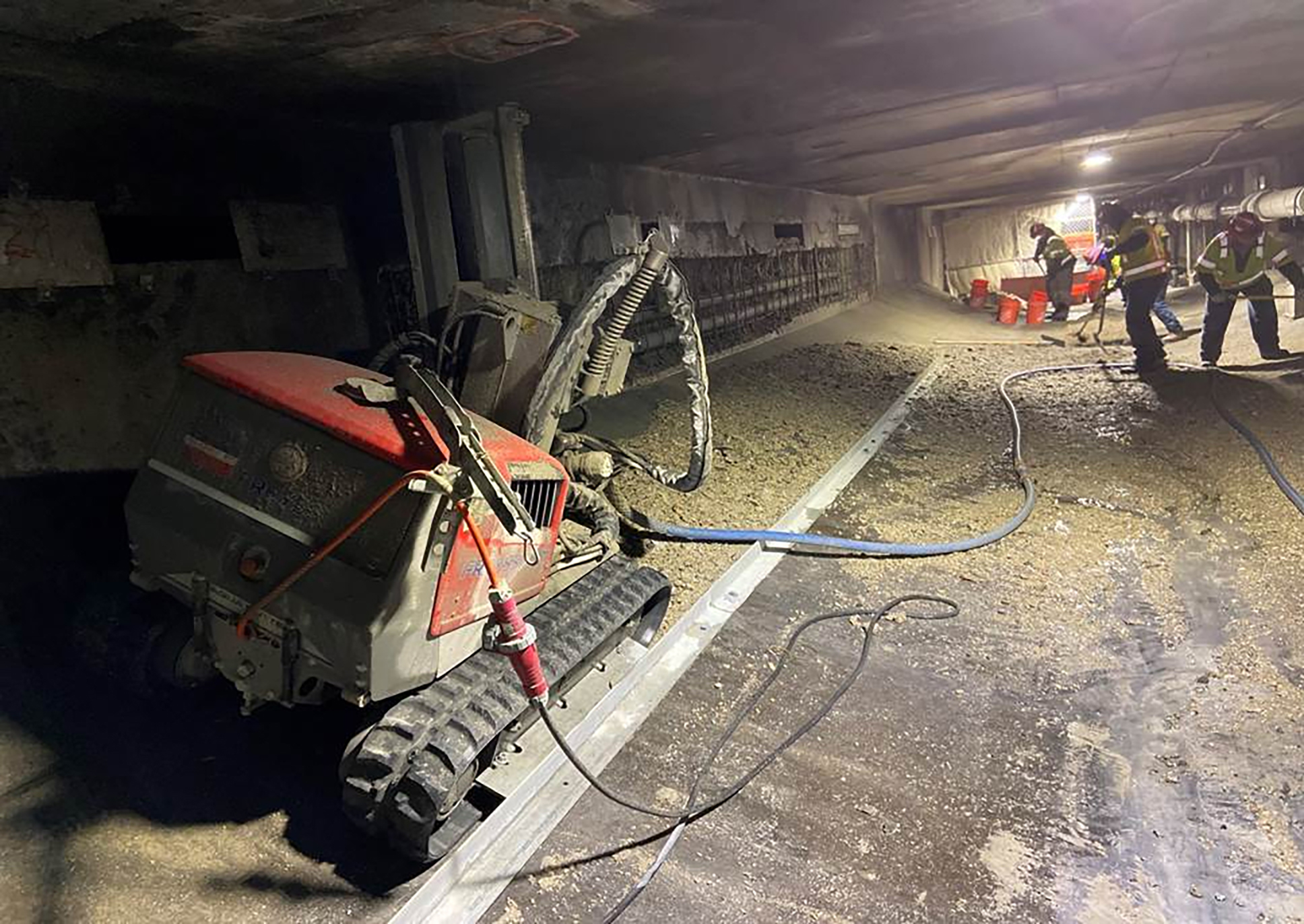
The Fort McHenry Tunnel is a unique structure that connects the harborside Locust Point and Canton areas of Baltimore. It stands out because it crosses under the Patapsco River just south of historic Fort McHenry. The four-tube tunnel is a vital link in Interstate 95 — the main North-South interstate highway on the East coast — that spans eight lanes and sees more than 100,000 vehicles pass through each day.
With large structures like the Fort McHenry Tunnel comes considerable ongoing maintenance. A current project involves removing and replacing two 4-inch conduits buried in a mile-long wall in the ventilation plenum below the roadway. The conduits house 15,000-volt cable that powers the tunnel facility. The scope of the work also includes 26,000 cubic feet of concrete rehabilitation to the underside of the roadway slab and side walls supporting it.
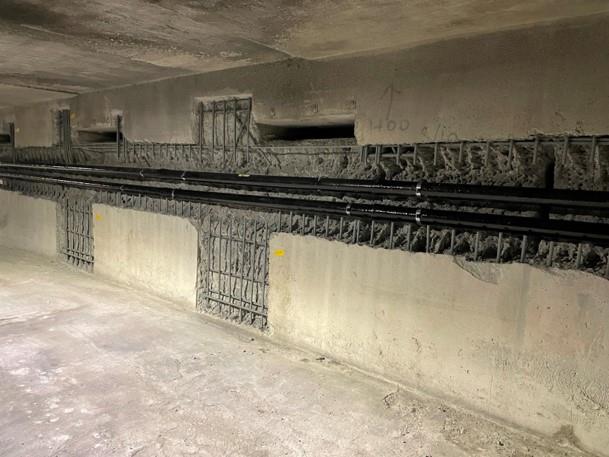
Hydrodemolition was specified for the project due to health and safety requirements in the tunnel beneath the river. Dust from impact demolition — such as jackhammering — poses several serious risks. First, flammable material is prohibited and could cause flames to quickly spread in the event of a fire. Second, giant fans force air through the tunnel during traffic jams and emergency situations, such as a car fire. If there was a layer of dust when the fans kicked in at 60 mph, it would cause whiteout conditions with silica-laden dust. These situations could be disastrous for everyone in the tunnel. With Hydrodemolition, there is no dust due to using water to remove the concrete.
The Maryland Transportation Authority set out to choose a contractor for what would prove to be a daunting task. The contractor would need to employ Hydrodemolition methods to remove a large amount of material in the ventilation plenum that was a cold, windy, dirty environment. Freyssinet, Inc. was awarded the project with a bid of nearly $30 million.

Freyssinet USA, out of Sterling, Virginia, is a business unit of the worldwide Freyssinet umbrella and a subsidiary of Vinci Construction. Freyssinet offers an array of products and services. It originally specialized in post-tensioning and heavy lifting, but has expanded its portfolio into stay cables, structural cables, repair, refurbishment, bridge bearings and vertical reinforcement, civil, marine, manufacturing, commercial and residential sectors.
The business pursued Hydrodemolition techniques specifically for the Fort McHenry Tunnel project. Though some in the company had dabbled in Hydrodemolition previously, none had experience with anything to the magnitude of the tunnel project. This big leap into the world of Hydrodemolition required meticulous planning to find the right tools for the job.
Freyssinet Mid-Atlantic Operations Manager Wayne Campbell conducted considerable research on Hydrodemolition equipment options, including discussions with one of Freyssinet’s sister companies that has extensive Hydrodemolition experience. Ultimately, he chose Aquajet based on expert recommendation and the level of service and support the manufacturer would provide.
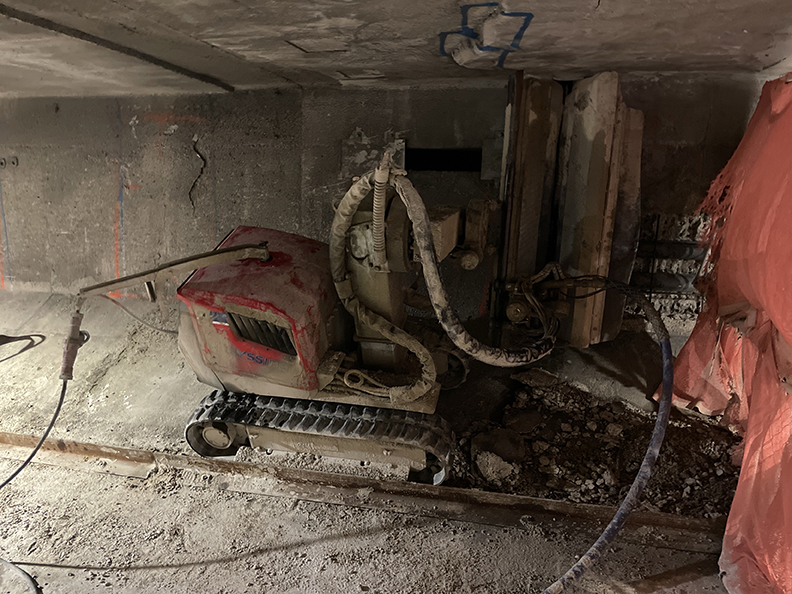
Freyssinet’s portfolio highlights extraordinary projects across several continents. The Fort McHenry Tunnel job stands on its own, however. Not only is the worksite beneath the tunnel roadway in a cold, dirty, wet, environment, but being restricted to working at night throws more obstacles into the mix, such as limited access to the worksite and difficulty obtaining supplies not already on hand.
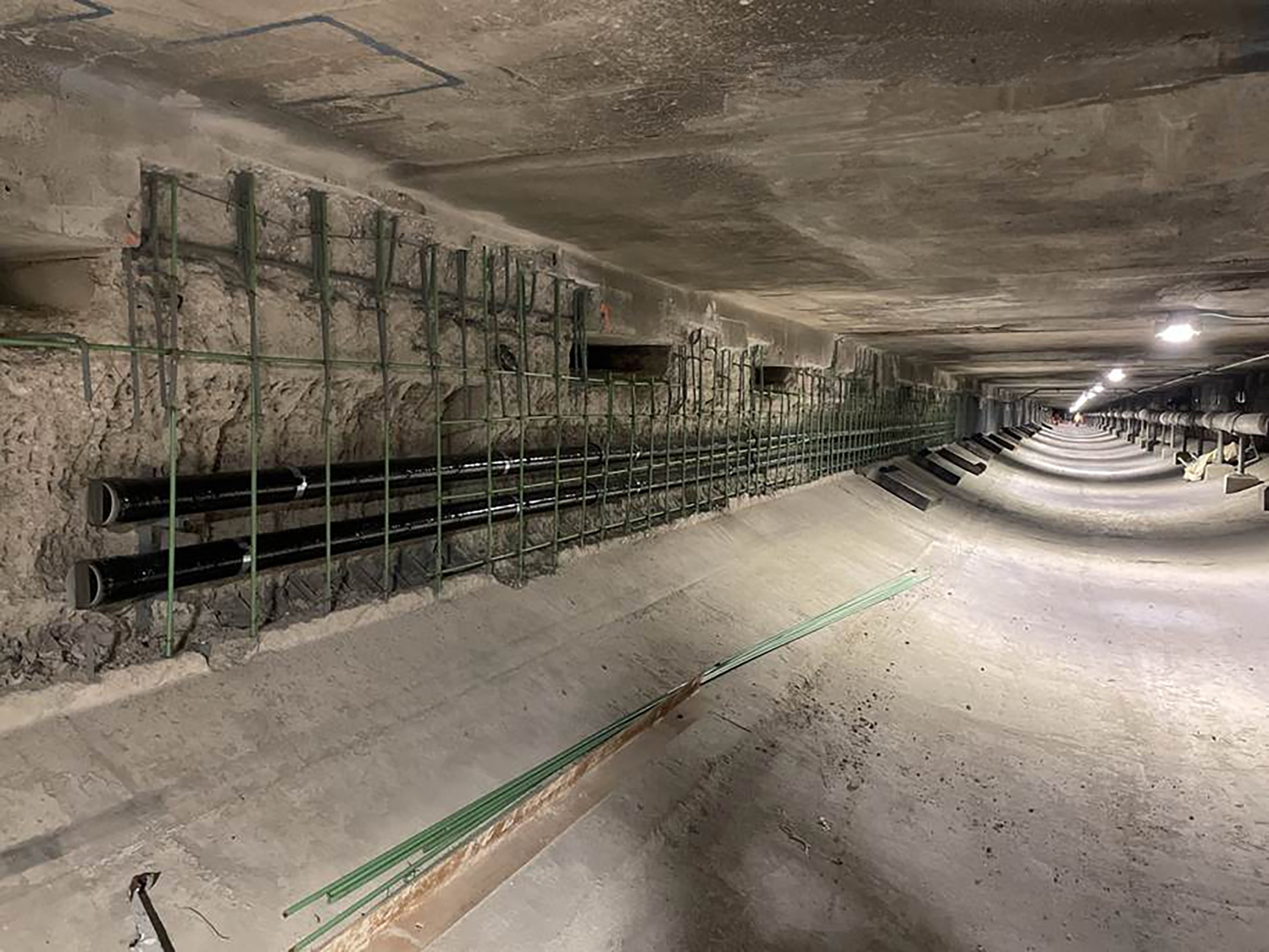
Ceilings of the workspace only stretch around 6 feet tall at their highest point, making powerful but compact equipment a necessity. Campbell formed a fleet of Aquajet machines featuring three Aqua Cutter 410As to tackle the daunting project. With its compact size and electric motor, the 410A is the ideal Hydrodemolition robot for a limited-access, underground setting like the Fort McHenry Tunnel. The 410A’s hydraulic and articulated arm features two rotating joints and three extensions that allow the hood to tilt and remove concrete on the tunnel wall and overhead roadway deck. The 15-man crew uses the Aqua Cutters to remove portions of the wall 30 inches tall and about 12 inches deep for a total distance of 4 miles to access the cables and conduit. Each shift, they remove about 6 cubic yards (162 cubic feet) of concrete and replace the conduit and rebar each shift. The final step is to finish the repair with shotcrete.
Two robots run during the shift while the third is rotated out for maintenance. To get the Aqua Cutters into the worksite, Freyssinet lifted them in with a crane through access hatches into the pump room at the bottom of the tunnel structure. They had to remove the hoods and cutting heads to navigate the narrow passages, stairways and doors with 1 inch of clearance. With the challenges getting equipment in and out of the tunnel, routine maintenance is performed inside the tunnel and can be completed during the shift without impacting production Crew members are typically spread more than 1,000 feet apart during a shift in the name of safety.
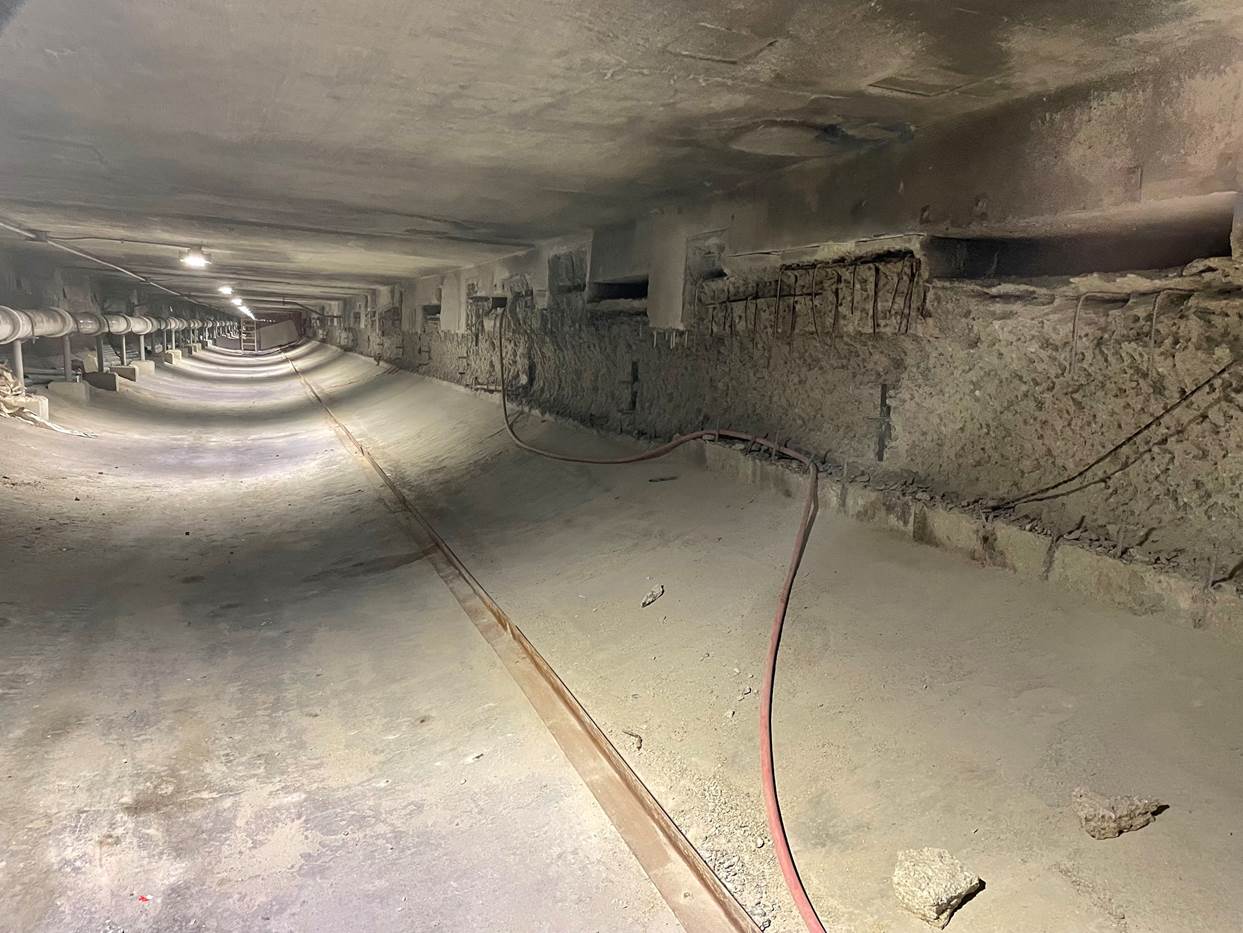
The shape of the tunnel creates challenging angles on the work surface. It’s a semicircle that turns vertical at the walls with only two short flat spots on each end. The other 5,000 or so feet are like working in a pipe cut in half, creating an angle on which the robots travel. Freyssinet built a rail system to ensure the robots stay on track during operation.
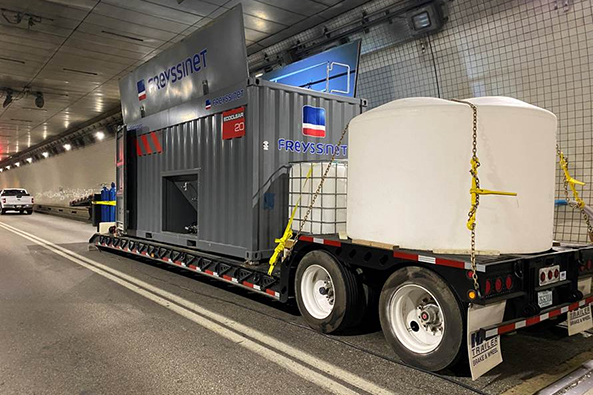
Freyssinet performs Hydrodemolition in the tunnel below the roadway during 10-hour overnight shifts, six of which are dedicated to Hydrodemolition. The other four hours are used to set up, tear down and move the mobile operation. The road is closed during the shift and then reopens to traffic in the morning. As a result, they must move any equipment positioned on the roadway, including a tool trailer, debris trailer, two high-pressure pumps towed by a semi, a 5,500-gallon tanker truck, a concrete pump, a 500-gallon water trailer, four generators, a flatbed truck loaded with concrete and their Aquajet EcoClear water treatment system. The EcoClear is a self-contained unit in a 20-foot Conex container that is mounted on a lowboy trailer. This setup allows the crew to pack up and drive off at the end of each shift. All hoses for the water and power run through 4-inch fresh air vents from the roadway down to the tunnel basement.
Hydrodemolition projects generally require methods of collecting and treating the water used in the process. Throughout the six-hour work shift, the 410As each push out 42 gallons of water per minute. Campbell purchased the EcoClear specifically for this task. The EcoClear features a compact footprint and user-friendly operation and treats wastewater on-site with minimal monitoring.
The Freyssinet crew made a surprising discovery about the EcoClear once they had their system up and running. Their water source stems from a 5,500-gallon tanker truck. Without recycling water, the crew would use about six tankers per shift, but they’re only using about one. This provides not only considerable time savings, but also cost savings in both water and fuel consumption. The EcoClear, which can process as much as 5,283 gallons per hour, recycles the water five times during the work shift. Campbell anticipated losing about 40% of the water to the atmosphere during the Hydrodemolition process; however, they’re retaining nearly all the water by using in a closed-loop system, in which they continually treat and recirculate the water.
“The EcoClear is like a furnace in your house,” Campbell said. “When it’s operating, you don’t have to think about it. You just check the sensors and let it run. In essence, it’s become the centerpiece of this job. The tunnel is a mile long and we have no water source, no spigot, and no drain, so all water has to come and go with us, and the EcoClear is the key that makes that happen.”
The crew’s work and problem solving on this job hasn’t gone unnoticed. Freyssinet representatives have traveled all the way from France and Norway to view the jobsite.
“This is a unique project with a straightforward task. My superintendent and I agree that this is not a complicated job. All we’re doing is ripping out conduit and putting it back in, but there’s nothing easy about it,” Campbell said. “You’re on an island when you work at night. Since we’re working outside of normal business hours, access to the outside world can be limited. As simple as this job is, this is one of the most difficult projects I’ve ever seen.”

The Fort McHenry Tunnel marks just the start of Freyssinet’s Hydrodemolition work. With their fleet of Aqua Cutters and EcoClear wastewater treatment system, Campbell’s vision is to take on more projects and grow that aspect of the business.
“My personal vision is that we just created the Freyssinet Hydrodemolition division,” Campbell said. “We have all the equipment necessary — three robots, three pumps and an EcoClear — so my vision is to send them out and put them to work.”
Work on the Fort McHenry Tunnel began in April 2021 and has an expected completion date of June 2026.